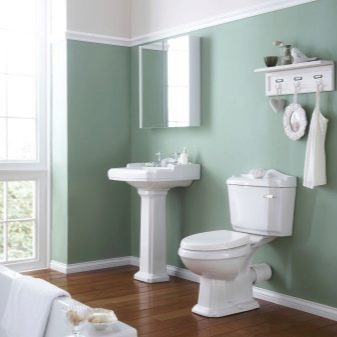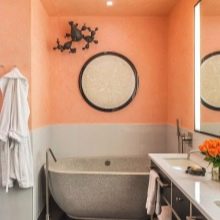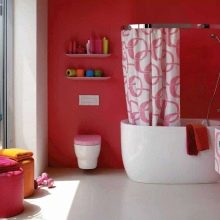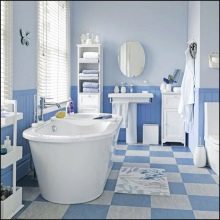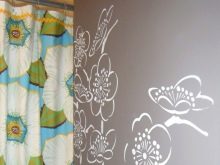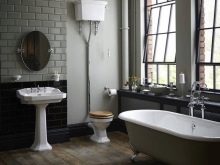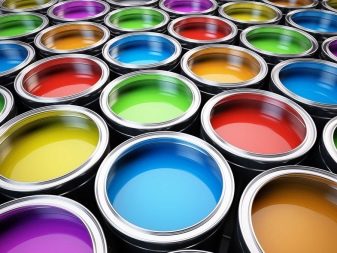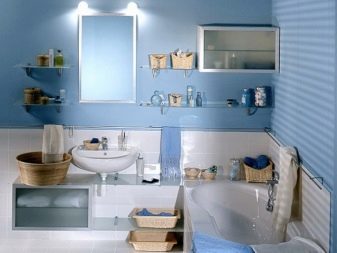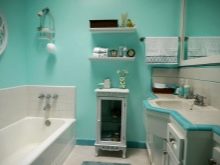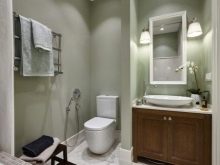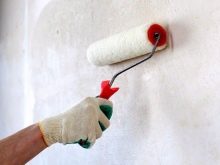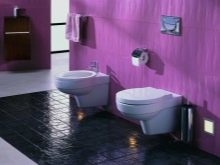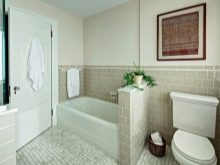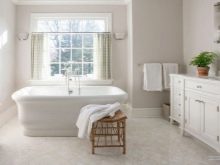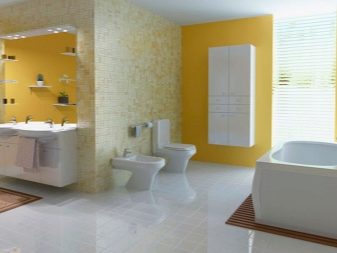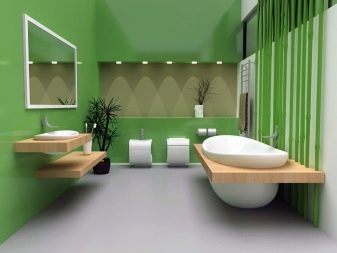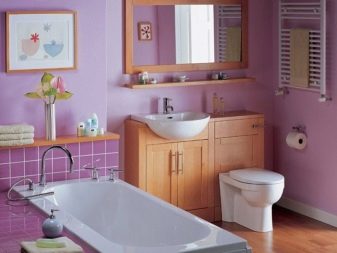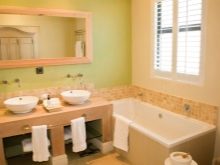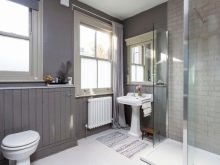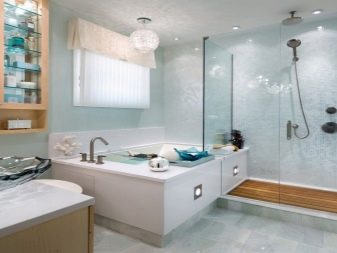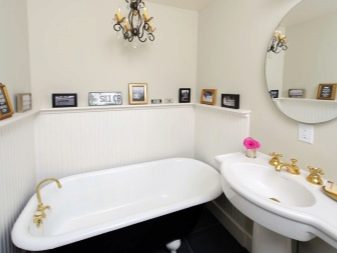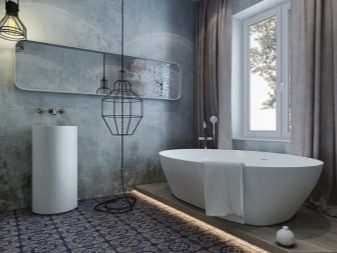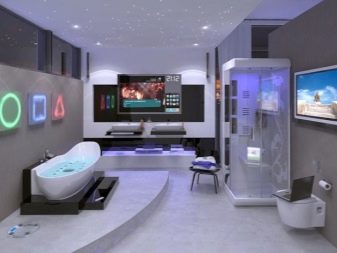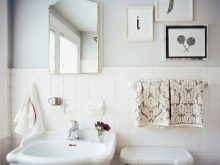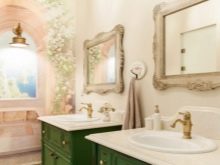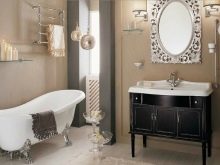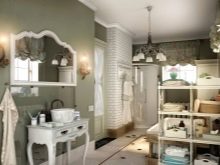Features painting the walls in the bathroom
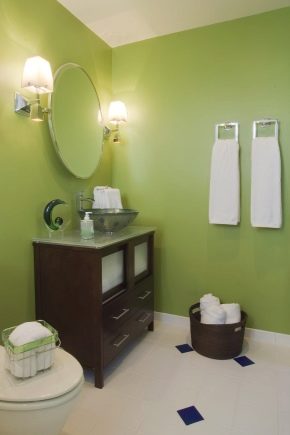
Painting walls as a bathroom interior is gaining in popularity and replacing tile. Most people are attracted to this option with ease of use and affordable prices. Before starting work, you should study the peculiarities of the process and the differences between types of paints.
Special features
Anyone with their own power can paint the walls in the bathroom or bath. Before starting work it is recommended to familiarize yourself with the intricacies of the process.
- Paints differ in reasonable cost and usability. The product forms a uniform coating that is easy to care for.Care is to treat the surface with a damp cloth.
- The painted walls transform the interior of the bathroom and make it interesting. Coloring is a wide scope for the implementation of their own ideas. You can use paints of different shades and create fancy patterns or strict lines. People with the talent of the artist will be able to draw real pictures in their bathroom.
- The paint looks originally combined with other materials, for example, with a regular tile.
These features make staining a popular and very budget way to transform the walls in the bathroom. Due to the availability of material, more and more people prefer this design option for their home.
Style and design
Buyers have access to many shades of paint, with the help of which they will be able to create an individual interior in their bathroom or toilet.
Designers offer many different design ideas.
- Recently, it is fashionable to apply paint with patterns and patterns. Homogeneous coating is considered boring, so experts recommend using the material in a combination of several shades, textures, drawings, etc.
- It looks interesting coloring walls stripes.Carefully select the colors so that the shades combine with each other and do not look pretentious. With the help of strips you can arrange the room in different styles. The game with a color palette allows you to significantly transform any room.
- Creatively look ornaments on the walls. Samples of patterns can be bought in the store or make yourself. Stencils allow you to create unique patterns that have a bright personality.
- With the help of paints you can divide the space and emphasize the various functional areas. Properly using color solutions, you can create a cozy bathroom in the style of hi-tech or art deco.
How to paint?
To paint the walls in the bathroom, you need to decide on the appropriate type of material. Manufacturers offer different types of products that are highly resistant to moisture and excellent quality. Consider the most appropriate options.
- Water emulsion. It is an odorless waterproof paint. It contains special additives that protect the coating from smearing over the surface. The material perfectly tolerates high humidity and steam exposure.
- Oil colors practically not used in the decoration of such premises. The material is resistant to moisture, but with temperature drops begins to peel off from the walls.
For this reason, the paint received numerous positive feedback from users. Aqueous emulsion paint can handle any walls, even those that are not exposed to moisture.
- Alkyd enamel considered to be the best option to protect the walls from getting wet. After drying, the enamel forms a solid film, so the wall acquires almost complete immunity to moisture. However, this solution does not appeal to users who choose odorless paint. Even a couple of days after dyeing, the scent of paint will be felt in the room.
- Experts recommend using when painting the bathroom acrylic latex complexes. Products have a high level of adhesion to all bases, toxicity is unusual for them, and also they are easy to use. Acrylic has good moisture resistance, so it is often used in rooms with a high level of humidity.
- Silicone paints - A worthy option for finishing the bathroom.Silicone compounds have high resistance to moisture and high cost. The high price scares many buyers, but the price tag is justified by the quality of the material.
Before applying any type of paint, you should carefully level the surface. Putty, which you will be finishing the base, must have anti-fungal properties to withstand the effects of water and the formation of mold. Paint the walls with a brush or roller. If the bathroom has a large area, it is more convenient to use a spray. Aerosol quickly copes with a large amount of work, but when using it, care should be taken to preserve the ceiling and floor. The sprayer can stain other surfaces that cannot be painted.
The brush allows you to paint all the corners and hard to reach places. Experts recommend using an aerosol can and a pair of narrow brushes in the work so that the coloring process is of high quality.
Training
Before starting the painting process, it is necessary to prepare the surface. To ensure high-quality paint application, you only need to work with a dry coating.Otherwise, condensate will accumulate under the painted layer, which will reduce the service life of the coating. Smooth and treated surface is the key to perfect adhesion of the finishing material to the walls.
Processing walls consists of several stages.
- Dismantling the old coating. For work, prepare sandpaper, spatulas, scrapers, grinders. Remove old paint with a special solvent.
- Then you need to prepare a draft basis. Walls need to be plastered or trimmed with moisture-resistant plasterboard. Wait for the plaster to dry, and proceed to the next step.
- If there are irregularities and cracks on the walls, they need to be puttied with acrylic or latex deep penetration putty, which is designed to work with a rough substrate. Before you begin to putty, do not forget to put a primer on the walls.
- Then you will need to go primer for the finishing layer. Apply the product in several layers. Each of them is applied after the previous one is completely dry.
Paint on the walls
After the surface is completely dry, it is possible to start the painting process. Painting the walls in the bathroom do it yourself is available to anyone. Even a novice who has not previously had experience with paints will cope with this process. To perform all actions correctly, you must follow the basic rules.
Act should be step by step.
- Paint masking tape will help protect surfaces and objects that are not intended to be painted. Painting hard-to-reach places should be done with a brush.
- If the surface is uneven, use a brush to start painting. It is able to apply paint in a thicker layer and mask the surface defects.
- The smooth basis is recommended to be painted with the roller. This item evenly paints the walls and reduces material consumption.
- The coloring composition before application must be prepared. Stir the paint and add color to it in the desired shade, if necessary.
- The first layer is diluted with a solvent.
- The second coat of paint is applied only after the first is completely dry. In the process of work may require several layers.
- When painting the walls should follow the absence of streaks and undyed areas.
- The composition should have a homogeneous structure and not have impurities.
Surface types
The paint can be applied to any surface: brick, wood, plaster, moisture-proof plasterboard, concrete walls, stone, and even wallpaper. Choosing paint, make sure that it is suitable for working with the material of the walls of your bathroom. Compatibility information is present on the product packaging. Regardless of which walls are to be painted, they must be prepared without fail. Depending on the condition of the walls, they can undergo a process of leveling, puttying, priming, etc.
Colors
The choice of color is an important point in painting the walls, as the color affects the perception of the situation, the mood of the household. It is desirable at the design stage to decide on the colors in which the bathroom surfaces will be painted.
The bathroom is the room in which people relax.Therefore, designers recommend using a calm color palette.Lilac-lime colors are the best option for creating a light and peaceful atmosphere. White shades are considered universal. However, an excessive amount of this color can spoil the perception of the interior. Painting all the walls in a snow-white shade will lead to the fact that the bathroom will have a “cold space” that is present in medical institutions. In order to exclude the occurrence of such associations, it is recommended to replace whites with milky or cream tones.
Use of bright colors will help to revive the cold interior. The combination of white with black, burgundy and red will look original. Pick colors correctly so that the interior does not look too aggressive.
Different colors can be used for zoning the space or underscore the individual functional areas. Many people emit the shower area in contrasting colors or patterned framing against the background of soothing tones.
Tips
Competent advice from professionals will help in creating an interesting bathroom design with paints.
The work should take into account certain subtleties.
- The original effect is obtained by alternating tiles with paint. With this solution, the design of the room becomes unusual and interesting.
- It is possible to carry out coloring in rooms with high-quality ventilation. Only if this rule is observed, the interior will remain attractive for a long time. Periodically, you need to open the door and ventilate the room so that drier air masses enter the room.
- Before painting process, pay attention to the corners of the room. They must not contain defects and flaws. Any flaws will be visible to the naked eye under a layer of paint.
- Before buying paint you need to make sure that it is intended for painting the bathroom. If there is no such information on the product packaging, the paint is most likely not suitable. Specialized formulations contain mold inhibitors, due to which the coating will not be afraid of damp.
- Washable colors - this is the best option for such premises. Information about this should also be present on the packaging. Such materials are easy to maintain.With the help of conventional detergents, you can remove yellowness and other contaminants from the surface of the walls.
- When painting, you should paste over the sink, the corners of the bathroom, the surface of the floor with adhesive tape or newspapers so as not to stain.
- Designers do not recommend painting the entire room with paint. Places where water often gets (the floor surface, the area near the shower, sink), it is better to veneer tiles or plastic panels.
Successful examples and options
There are many original options with which you can transform the bathroom. In the process of creating a design project, most people wonder what style it is best to arrange for a room so that it can provide maximum comfort.
A popular classic interior. It will be interesting and stylish to look even in the "Khrushchev". To create a suitable paint colors of light shades. Milky color looks very gently in small rooms and visually increases the space.
For the bathroom, decorated in a modern high-tech style, you should choose cool and strict shades. In the palette there are gray and blue tones.To make the interior complete, some designers add shelves of tempered glass to the decor.
Provence - an interesting solution for interior design. For this direction you should choose pink, blue, purple and beige tones. The ceiling should be dull. Beautifully in this design will look hand-drawn ornament with floral motifs.
For lovers of antiquity there is a retro style. It should contain bright or unusual colors, images of comics or joyful, positive pictures. This style is also suitable for an apartment that is decorated in the spirit of pop art or art deco.
More tips on painting the walls in the bathroom are waiting for you in the next video.

